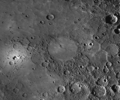English: *Instrument: Narrow Angle Camera (NAC) of the Mercury Dual Imaging System (MDIS)
- Scale: Copland crater has a diameter of 208 kilometers (129 miles)
- Projection: This image is a portion of the NAC approach mosaic from Mercury flyby 3. It is shown in a simple cylindrical map projection with a resolution of 500 meters/pixel (0.31 miles/pixel).
Of Interest: Visible in the center of this image is the crater Copland, recently named in honor of the American composer and pianist Aaron Copland. Aaron Copland and this crater are both unquestionably worthy candidates for named features on Mercury, but how this specific crater came to be known as Copland has an interesting back-story. Amateur astronomer Ronald Dantowitz and his colleagues Scott Teare and Marek Kozubal used the Mt. Wilson 60-inch telescope in 1998 to observe a very bright feature on this portion of Mercury's surface, and they assumed that the bright feature was an impact crater. Mr. Dantowitz expressed his wish that the crater be named "Copland" once better images of the area were obtained from spacecraft. Surprisingly, MESSENGER images from Mercury flyby 3 revealed that the small bright feature, seen at the left edge of this image, is not an impact crater but more closely resembles a volcanic vent! No convention for naming volcanic vents on Mercury has yet been adopted, because none were identified prior to MESSENGER's first Mercury flyby. However, even if a convention for naming volcanic features on Mercury is adopted in the future, the naming rules will likely differ from those for impact craters, and thus "Copland" would probably not be an acceptable name for the bright volcanic feature. A MESSENGER team member corresponded with Mr. Dantowitz and suggested that the name Copland be proposed instead for a large crater nearby. He agreed, and the International Astronomical Union (IAU) approved the name Copland on March 3, 2010. Copland crater is flooded with volcanic smooth plains material that could be related to the activity that formed the bright vent.





